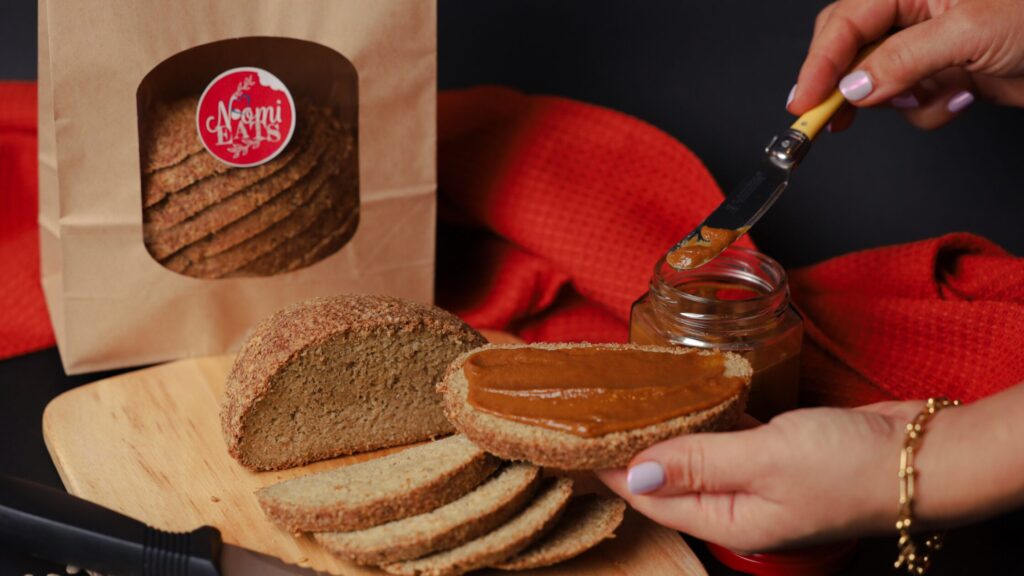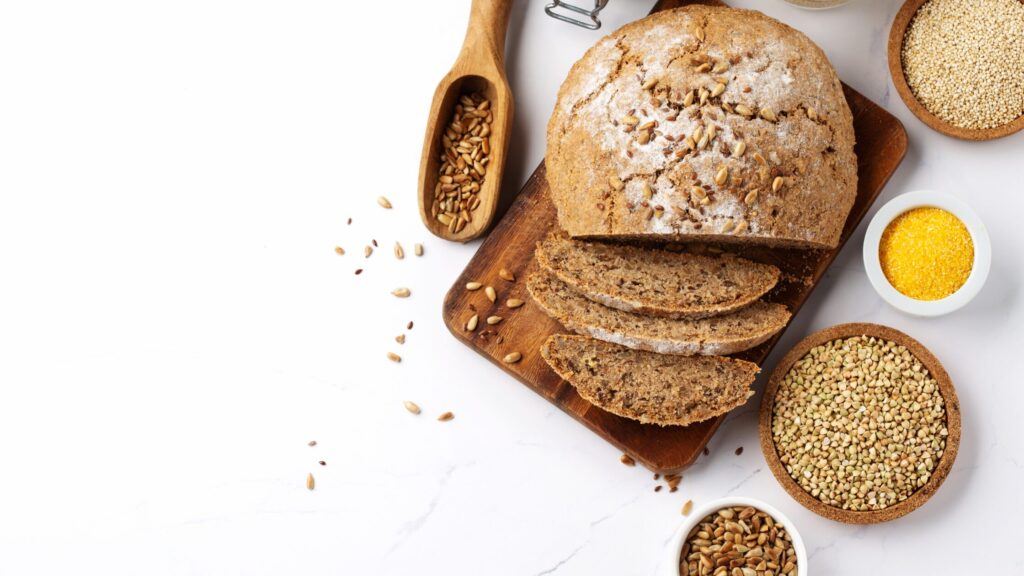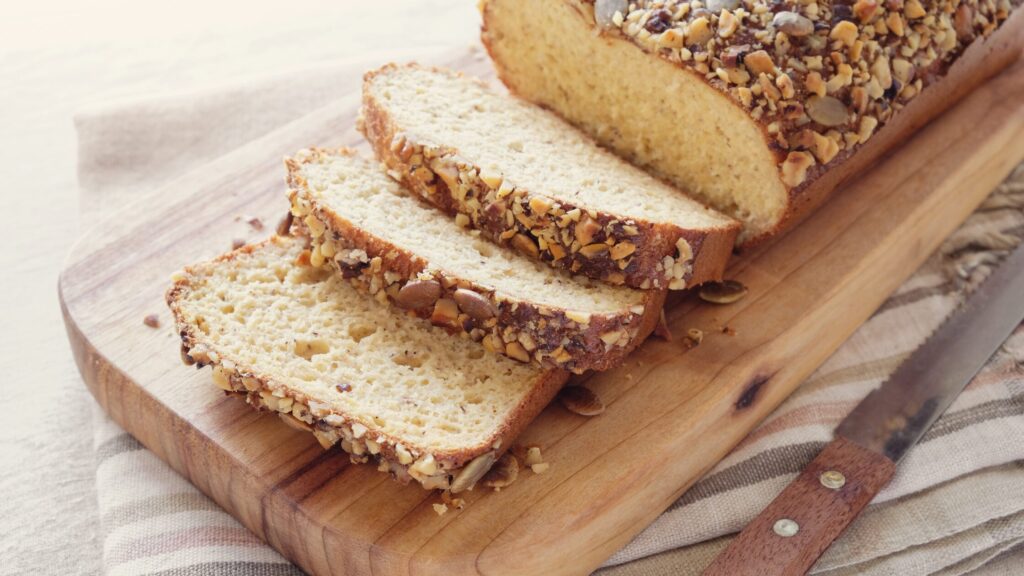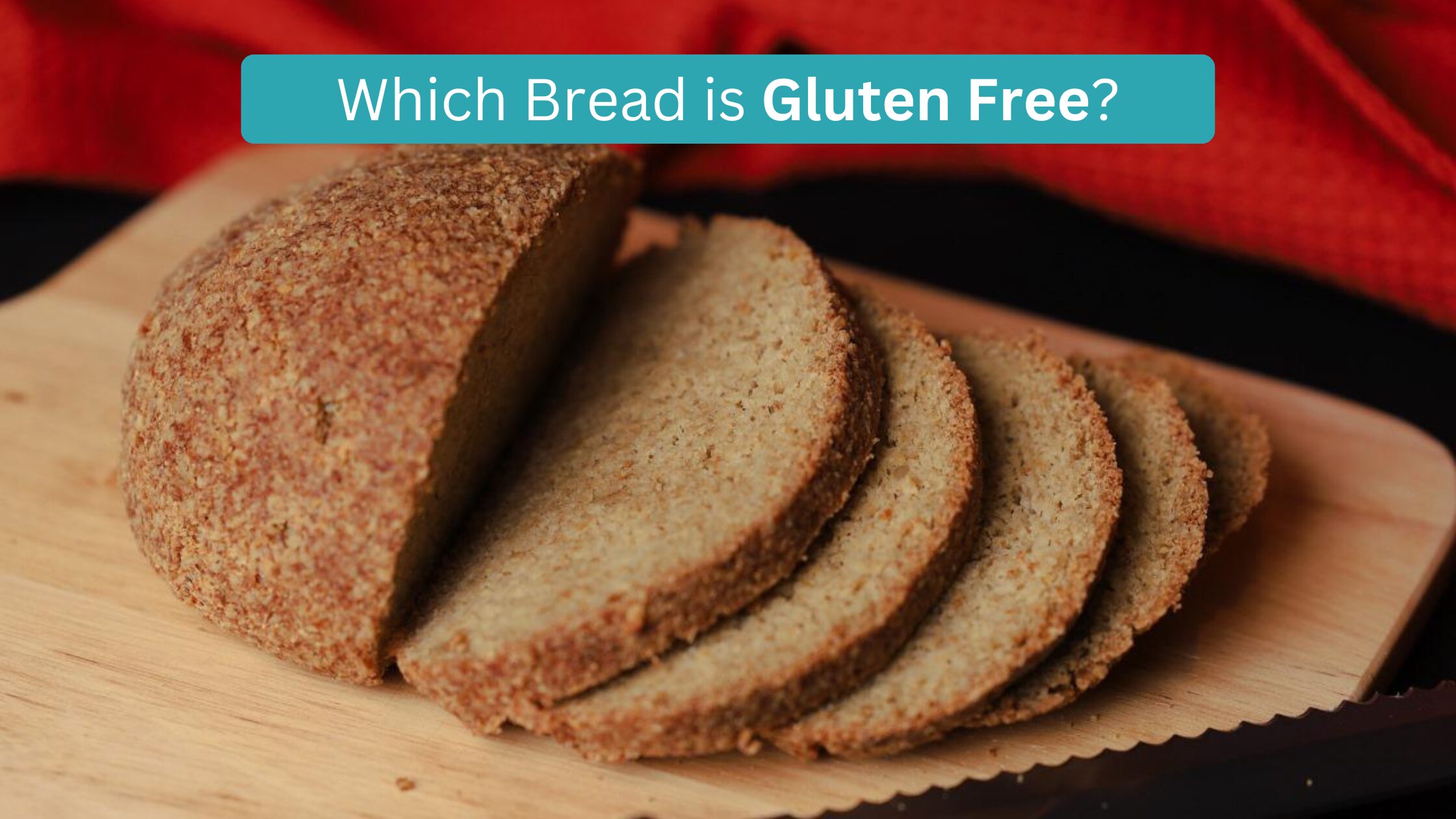Gluten-free bread has become increasingly popular in recent years, catering to many people who need or choose to avoid gluten for various reasons. Gluten is a protein found in wheat, barley, and rye, and it helps baked goods maintain their shape by providing elasticity and moisture.
Why Avoid Gluten?
1- Celiac Disease
- For individuals diagnosed with celiac disease, consuming gluten triggers an autoimmune response that damages the lining of the small intestine. This can lead to severe digestive issues and hinder the body’s ability to absorb nutrients.
2- Non-Celiac Gluten Sensitivity
- Some people experience symptoms similar to those of celiac disease, such as bloating, diarrhea, and abdominal pain, despite testing negative for the condition. This is referred to as non-celiac gluten sensitivity, and a gluten-free diet often alleviates their symptoms.
3- Wheat Allergy
- A wheat allergy is an immune system reaction to proteins found in wheat, including but not limited to gluten. Those with a wheat allergy must avoid wheat products, which often include opting for gluten-free alternatives.
4- Lifestyle Choice
- Others might choose a gluten-free diet as a part of a lifestyle choice, believing it to be healthier or to improve various health conditions, such as irritable bowel syndrome or other gastrointestinal disorders.
What is Gluten Free Bread?

Gluten-free bread is made with alternative flour that do not contain gluten, such as rice flour, almond flour, tapioca flour, or a blend of other non-glutenous grains and legumes. These breads are designed to mimic the texture and taste of traditional bread without triggering adverse reactions in those sensitive to gluten.
Choosing gluten-free bread involves understanding the types of flour used and ensuring that the products are certified gluten-free to avoid cross-contamination during production. The demand for gluten-free bread has led to a wide variety of options in supermarkets and specialty stores, making it easier than ever to find a suitable alternative to traditional bread.
Ingredients in Gluten-Free Bread
1- Alternative Flours
- Rice Flour: One of the most common bases, rice flour provides a neutral flavor and is often combined with other flour to create a well-rounded bread.
- Almond Flour: Made from ground almonds, this flour adds moisture and a slightly nutty taste. It is high in protein and healthy fats.
- Tapioca Flour: Derived from the cassava root, tapioca flour is excellent for thickening and adds chewiness to gluten-free bread.
- Sorghum Flour: This mildly sweet flour is rich in nutrients and often used to enhance gluten-free bread’s flavor and nutritional profile.
- Chickpea Flour: Also known as garbanzo bean flour, this option adds a robust flavor and is high in protein and fiber.
2- Binding Agents
- Xanthan Gum: A common additive in gluten-free baking, xanthan gum helps mimic the elasticity and structure of gluten.
- Guar Gum: Similar to xanthan gum, guar gum is another binding agent that improves the texture and cohesiveness of gluten-free dough.
- Psyllium Husk: A natural source of soluble fiber, psyllium husk helps to bind the ingredients together and adds moisture to the bread.
3- Leavening Agents
- Yeast: Traditionally used in bread making, yeast helps gluten-free bread rise and develop a light, airy texture.
- Baking Powder: Often used with yeast, baking powder provides additional leavening in quick breads and some gluten-free recipes.
Production and Certification
Ensuring that gluten-free bread is genuinely free of gluten involves rigorous production standards. Manufacturers must use dedicated gluten-free facilities or production lines to avoid cross-contamination with gluten-containing grains. Many brands also seek certification from organizations such as the Gluten-Free Certification Organization (GFCO) to affirm their adherence to strict gluten-free standards.
Nutritional Considerations
While gluten-free bread can offer a safe alternative for those with gluten sensitivities, it’s important to note that the nutritional content can vary widely depending on the ingredients used. Some gluten-free breads are fortified with additional vitamins and minerals to compensate for potential deficiencies. Consumers should read labels carefully to select a bread that meets their nutritional needs.
Availability and Options
The market for gluten-free bread has expanded significantly, leading to a broad array of choices in supermarkets and specialty stores. From sandwich loaves to artisan bread, consumers can find gluten-free options that suit their taste and dietary requirements. Some brands have even developed frozen gluten-free bread products to maintain freshness and extend shelf life, offering greater convenience for people on gluten-free diets.
Difference Between Gluten-Free Bread and Regular Bread
Understanding the differences between gluten-free and regular bread is crucial for those with dietary restrictions or preferences. Here are the key distinctions:
Ingredients
- Regular Bread: Typically made from wheat flour, which contains gluten. Other common grains include barley and rye.
- Gluten-Free Bread: Made using alternative flour such as rice flour, almond flour, chickpea flour, and tapioca flour. These flours do not contain gluten, making the bread safe for those with celiac disease or gluten sensitivity.
Texture and Taste
- Regular Bread: Known for its chewy texture and elastic crumb, attributes provided by gluten.
- Gluten-Free Bread: Often denser and may have a different texture due to the absence of gluten. However, binding agents like xanthan gum or guar gum are used to mimic the elasticity.
Nutritional Profile
- Regular Bread: Generally a good source of protein and fiber, along with various vitamins and minerals from wheat.
- Gluten-Free Bread: Nutritional content can vary widely. Some brands enrich their bread with additional nutrients to address potential deficiencies. Check the nutritional content of your chosen brand.
Production Process
- Regular Bread: Made in facilities that handle gluten-containing grains.
- Gluten-Free Bread: Must be produced in designated facilities to avoid cross-contamination. Certification from organizations like GFCO can provide peace of mind regarding purity.
Common Ingredients in Gluten Free Bread
Understanding the ingredients in gluten-free bread can help consumers make informed choices and find the best alternatives for their needs:
Alternative Flours
- Rice Flour: Frequently used due to its neutral taste and versatile nature.
- Almond Flour: Adds moisture and a nutty flavor, high in protein and healthy fats.
- Chickpea Flour: Robust flavor, rich in protein and fiber.
- Tapioca Flour: Derived from the cassava root, adds chewiness and thickness.
- Sorghum Flour: Mildly sweet, nutrient-dense, enhances the overall flavor.
Binding Agents
- Xanthan Gum: Mimics the elasticity and structure of gluten.
- Guar Gum: Another binding agent that improves texture.
- Psyllium Husk: Adds moisture and cohesiveness, sourced from natural soluble fiber.
Leavening Agents
- Yeast: Essential for bread rising and airiness.
- Baking Powder: Provides additional leavening, which is especially useful in quick bread recipes.
For further information on gluten-free living, visit trusted resources like the Celiac Disease Foundation, which offers extensive guides and support.
By understanding these differences and common ingredients, you can better navigate the world of gluten-free bread, ensuring that you or your loved ones can enjoy tasty and safe bread options.
Types of Gluten Free Bread


1- Rice Bread
Rice bread is one of the most commonly found types of gluten-free bread. Made primarily from rice flour, it offers a neutral taste that can easily pair with various spreads and fillings. This bread tends to be lighter and softer when compared to other gluten-free options. Its mild flavor makes it a versatile choice for both sandwiches and toast. Many rice bread variants are also fortified with additional vitamins and minerals to bolster their nutritional profile.
2- Almond Flour Bread
Almond flour bread is a popular choice for those looking for a gluten-free option that is also low in carbohydrates. Made from finely ground almonds, this type of bread has a rich, nutty flavor and is high in protein and healthy fats. It is often moist and dense, making it a satisfying option for both gluten-sensitive individuals and those following a keto or low-carb diet. However, due to its nut content, it may not be suitable for individuals with nut allergies.
3- Sorghum Bread
Sorghum bread, made from sorghum flour, is known for its slightly sweet and earthy flavor. Sorghum itself is a nutrient-dense grain high in antioxidants and fiber, making it a nutritious choice for gluten-free bread. This type of bread often features a hearty texture, which can be particularly appealing in applications that benefit from a more robust bite feel. Sorghum bread is excellent for sandwiches and pairs well with both savory and sweet toppings.
4- Chickpea Bread
Chickpea flour, also known as garbanzo bean flour, is used to make chickpea bread. This type of bread is distinguished by its dense texture and slightly nutty, earthy flavour, thanks to its high protein and fibre content. It provides a unique taste profile that stands out among other gluten-free options. Chickpea bread is not only nutritious but also versatile, fitting well in both savoury dishes like sandwiches and alongside soups or salads.
5- Tapioca Bread
Tapioca bread is made from tapioca flour derived from the cassava root. Known for its chewiness and flexibility, tapioca bread has a texture that closely resembles that of traditional wheat bread. It is often used in Brazilian cuisine, most famously in pão de queijo, a cheesy tapioca bread roll. Although tapioca bread is light and chewy, it is usually low in protein and fiber, making it essential to pair it with nutrient-dense foods.
6- Buckwheat Bread
Despite its name, buckwheat is naturally gluten-free. Buckwheat bread, made from buckwheat flour, has a strong, slightly nutty flavor and a dense texture. High in minerals, especially magnesium and manganese, and rich in fibre, it is a nutritious choice. Buckwheat bread works well for sandwiches and as a wholesome toast option.
7- Quinoa Bread
Quinoa bread, made from quinoa flour, is another excellent gluten-free option. Quinoa is a complete protein, containing all nine essential amino acids, making quinoa bread particularly nutritious. It boasts a mild, slightly nutty flavor and a texture that is softer and more pliable than many other gluten-free pieces of bread. Quinoa bread is a versatile choice, ideal for sandwiches, toast, or even on its own as a snack.
8- Millet Bread
Millet bread is made from millet flour and has a mild, slightly sweet flavor. Millet is rich in magnesium, phosphorus, and iron, making it a nutritious addition to a gluten-free diet. Millet bread tends to be light and airy, providing a good crumb structure that can be reminiscent of traditional wheat bread. It is a great option for those seeking a healthy and gluten-free alternative.
9- Teff Bread
Teff bread is made from teff flour, which comes from an ancient grain native to Ethiopia. Teff is highly nutritious, boasting high levels of calcium, iron, and protein. Bread made from teff flour has a distinct, slightly sweet, and earthy flavor, along with a dense and moist texture. Teff bread is an excellent choice for those looking to incorporate more nutrients into their gluten-free diet.
Exploring these diverse types of gluten-free breads can help those with gluten sensitivities or dietary preferences find the best options to suit their needs and tastes. Each type offers unique flavors and textures, ensuring that there is gluten-free bread out there for everyone.
Unique Characteristics and Benefits of Different Types of Gluten-Free Breads
Rice Bread
- Neutral Taste: Pairs well with various spreads and fillings.
- Lighter and Softer: Compared to other gluten-free options.
- Versatility: Suitable for both sandwiches and toast.
- Nutritional Fortification: Often includes additional vitamins and minerals.
Almond Flour Bread
- Rich, Nutty Flavour: Derived from finely ground almonds.
- High in protein and healthy fats, which are beneficial for overall health.
- Moist and Dense Texture: Satisfying and hearty.
- Low Carbohydrate Content: Ideal for keto or low-carb diets.
- Allergy Consideration: Not suitable for those with nut allergies.
Sorghum Bread
- Slightly Sweet and Earthy Flavour: Unique and appealing.
- Nutrient-Dense: High in antioxidants and fiber.
- Hearty Texture: Suitable for robust sandwiches.
- Nutritional Benefits: Provides essential nutrients like iron and magnesium.
Chickpea Bread
- Dense Texture: Offers a filling bite.
- Nutty, Earthy Flavour: Distinct and flavourful.
- High Protein and Fibre Content: Supports dietary needs.
- Versatility: Complements both savory dishes and soups.
- Dietary Consideration: Generally free from common allergens, but check for any additions.
Tapioca Bread
- Chewy and Flexible: Closely resembles traditional wheat bread.
- Culinary Use: Popular in Brazilian dishes like pão de queijo.
- Light and Chewy: Pleasant texture.
- Low in Protein and Fibre: Pair with nutrient-dense foods for a balanced diet.
Buckwheat Bread
- Strong, Nutty Flavour: Distinctive and rich.
- Dense Texture: Hearty and substantial.
- Rich in Minerals: Especially magnesium and manganese.
- High Fibre Content: Promotes digestive health.
- Gluten-Free: Despite the name, completely safe for gluten-sensitive individuals.
Quinoa Bread
- Complete Protein: Contains all nine essential amino acids.
- Mild, Nutty Flavour: Pleasant and mild-tasting.
- Soft and Pliable Texture: More flexible than many gluten-free breads.
- Versatile Usage: Suitable for sandwiches, toast, or standalone snacks.
Millet Bread
- Mild, Slightly Sweet Flavour: Gentle and enjoyable.
- Rich in Magnesium, Phosphorus, and Iron: Offers significant nutritional benefits.
- Light and Airy: Pleasant crumb structure.
- Reminiscent of Traditional Wheat Bread: Appeals to those missing wheat bread texture.
Teff Bread
- Distinct, Slightly Sweet and Earthy Flavour: Unique and palatable.
- Dense and Moist Texture: Satisfying and substantial.
- High in Nutrients: Including calcium, iron, and protein.
- Ancient Grain: Steeped in history and tradition.
Understanding the unique characteristics and benefits of each type of gluten-free bread can assist individuals in making informed choices suited to their dietary preferences and health requirements. Recognising potential allergens and nutritional content ensures these options align with diverse dietary needs.
Popular Gluten-Free Bread Brands
Finding a reliable gluten-free bread brand can be challenging with so many options available on the market. Here, we have compiled a list of well-known gluten-free bread brands that offer a range of delicious and nutritious options:
1- Udi’s Gluten Free
Udi’s is one of the most recognized names in the gluten-free industry. They offer a variety of bread options, including sandwich bread, bagels, and even hamburger buns. Udi’s products are cherished for their texture and taste, which closely mimic traditional wheat-based bread.
2- Schär
Schär is a European brand with a broad selection of gluten-free products, including bread, rolls, and crispbreads. Known for their quality and commitment to natural ingredients, Schär’s breads often include added fiber and vitamins to enhance their nutritional value.
3- Canyon Bakehouse
Canyon Bakehouse is dedicated to making gluten-free bread that doesn’t compromise on taste or quality. They offer several varieties, such as 7-Grain, Mountain White, and Cinnamon Raisin. Their bread is also allergen-friendly, free from dairy, nuts, and soy.
4- Genius Gluten Free
Genius Gluten Free, a UK-based brand, provides a variety of gluten-free bread options that are soft and delicious. Their products range from traditional white and brown bread to more specialized options like multi-seed and super soft baps.
5- Rudi’s Bakery
Rudi’s Organic Bakery offers an extensive range of certified organic and gluten-free products. Their bread is praised for its wholesome, hearty texture. They provide options like multigrain, cinnamon raisin, and sandwich bread.
6- Franz Gluten Free
Franz Bakery offers gluten-free bread that is soft and pillowy, making it perfect for sandwiches and toast. Their gluten-free bread choices include homestyle white and 7-grain, and they are made with high-quality ingredients to ensure taste and nutrition.
7- NoomiEats
NoomiEats is a brand that caters specifically to gluten-free and keto-friendly diets within the UAE. They focus on providing high-quality bread that aligns with the dietary preferences and needs of their customers. Their offerings are well-regarded for both taste and health benefits, making them a go-to option for those looking for gluten-free alternatives in the region. Visit our page for various gluten-free bread options! Add our gluten-free heal bread to your daily diet.
8- Little Northern Bakehouse
Little Northern Bakehouse offers a variety of gluten-free bread options that also happen to be egg-free and vegan. Their bread is known for its light, airy texture and is free from many common allergens, making it a versatile choice for various dietary restrictions.
9- Three Bakers
Three Bakers is another trusted brand for gluten-free bread. They provide a range of options, including white, whole grain, and rye-style bread. Their products are praised for their soft texture and rich flavor, mimicking traditional bread as closely as possible.
10- Food for Life
Food for Life’s gluten-free offerings include their well-known sprouted grain bread line, such as the gluten-free version of their famous Ezekiel loaf. They focus on using sprouted grains and seeds, enhancing their bread’s nutritional profile.
These brands represent some of the best options for gluten-free bread, catering to diverse tastes and nutritional needs. Whether you’re looking for a traditional loaf, something more artisanal, or products that fit specific dietary requirements like keto, this list provides a great starting point in your search for the perfect gluten-free bread.
Gluten-Free Bread Recipes
Classic Gluten-Free Sandwich Bread
Ingredients:
- 2 cups gluten-free all-purpose flour
- 1/4 cup tapioca starch
- 2 tsp xanthan gum
- 1 packet active dry yeast (about 2 1/4 tsp)
- 1/4 cup sugar
- 1 1/2 tsp salt
- 3 large eggs
- 1 cup warm water (110°F)
- 1/4 cup olive oil
- 1 tsp apple cider vinegar
Instructions:
- Prepare the yeast: In a small bowl, combine the warm water and the active dry yeast. Stir gently and let it sit for about 5 minutes until it becomes frothy.
- Mix dry ingredients: In a large bowl, whisk together the gluten-free flour, tapioca starch, xanthan gum, sugar, and salt.
- Combine wet ingredients: In a separate bowl, beat the eggs, then add the olive oil and apple cider vinegar.
- Blend: Pour the yeast mixture and the egg mixture into the bowl of dry ingredients. Mix with a stand mixer fitted with a paddle attachment on medium speed for about 3-5 minutes, until smooth and thoroughly combined.
- Rest the dough: Transfer the dough to a greased loaf pan and cover it loosely with a damp cloth. Let it rise in a warm place for about 1 hour or until the dough has doubled in size.
- Bake: Preheat your oven to 375°F (190°C). Bake the bread for 35-40 minutes, or until the top is golden brown and a toothpick inserted in the center comes out clean.
- Cool: Let the bread cool in the pan for 10 minutes, then transfer it to a wire rack to cool completely before slicing.
Tips for Best Results:
- Texture: For a lighter texture, ensure your eggs are at room temperature before mixing.
- Flavor: Adding 1 tbsp of honey to the wet ingredients can enhance the sweet flavor profile of the bread.
- Storage: Store in an airtight container at room temperature for up to 3 days or freeze for longer storage.
Easy Quinoa Bread
Ingredients:
- 1 cup quinoa flour
- 1 cup gluten-free oat flour
- 3/4 cup almond flour
- 2 tbsp flaxseed meal
- 2 tbsp chia seeds
- 2 tsp baking powder
- 1/2 tsp baking soda
- 1/2 tsp salt
- 1 cup almond milk
- 2 large eggs
- 1/4 cup olive oil
- 1 tbsp honey
- 1 tsp apple cider vinegar
Instructions:
- Preheat oven: Preheat your oven to 350°F (175°C). Grease a 9×5 inch loaf pan and set aside.
- Mix dry ingredients: In a large bowl, combine quinoa flour, oat flour, almond flour, flaxseed meal, chia seeds, baking powder, baking soda, and salt. Whisk well.
- Combine wet ingredients: In another bowl, whisk eggs with almond milk, olive oil, honey, and apple cider vinegar.
- Blend together: Pour the wet ingredients into the dry ingredients and stir until combined. Let the batter sit for about 5 minutes to allow the chia seeds and flaxseed to absorb some liquid and thicken.
- Transfer and bake: Pour the batter into the prepared loaf pan, smoothing the top with a spatula. Bake for 45-50 minutes, or until a toothpick inserted into the center of the loaf comes out clean.
- Cool: Let the bread cool in the pan for 10 minutes before transferring it to a wire rack to cool completely.
Tips for Best Results:
- Texture: For a fluffier bread, ensure not to overmix the batter.
- Flavor: A pinch of cinnamon or nutmeg can add a delightful warmth to the bread.
- Storage: Wrap the bread in plastic wrap and store in the refrigerator for up to 5 days, or slice and freeze for up to 3 months.
These gluten-free bread recipes cater to various tastes and preferences, ensuring that even those with dietary restrictions can enjoy wholesome, homemade bread.
Tips for Choosing Gluten-Free Bread
When selecting gluten-free bread, it’s essential to be mindful of a few key factors to ensure you’re getting a high-quality product that meets your dietary needs. Here are some tips to guide you:
Reading Labels
Always read the ingredient labels carefully. Look for bread that is explicitly labeled as “gluten-free” to ensure there’s no cross-contamination with gluten-containing products. Check for whole, nutritious ingredients. Avoid bread with an excessive number of additives or chemicals, as they may affect taste and nutritional value. Also, watch out for added sugars or high levels of sodium.
Understanding Ingredients
Pay attention to the type of flours used. Good gluten-free bread often includes a blend of various gluten-free flours like rice, almond, tapioca, and sorghum flour. Ingredients like xanthan gum or guar gum are commonly used as binding agents that help improve the texture of gluten-free bread. Additionally, check for protein and fiber content, which can make the bread more nutritious and filling.
Texture and Freshness
Gluten-free bread can sometimes be denser than regular bread. Opt for brands known for a softer, airy texture if that is your preference. Freshness is also a significant factor; some brands offer freshly baked bread, while others might be frozen. Freshly baked options are usually more flavorful, but frozen varieties can be just as good if thawed and stored properly.
Storage Tips
Proper storage is crucial to maintain the freshness and quality of gluten-free bread. Store it in its original packaging in a cool, dry place if you’re consuming it within a few days. For longer storage, wrap the bread tightly in plastic wrap or aluminum foil and store it in the freezer. Freezing individual slices makes it easy to thaw just what you need without sacrificing the rest of the loaf. Refrain from refrigerating gluten-free bread, as this can cause it to dry out quickly.
By paying attention to these aspects, you can ensure that you’re choosing the best gluten-free bread for your dietary and taste preferences, preserving its quality for optimal enjoyment.
Conclusion
In summary, gluten-free bread can be a delicious and nutritious choice for those with dietary restrictions. By carefully selecting high-quality ingredients and paying attention to texture, freshness, and storage methods, you can enjoy a variety of gluten-free bread recipes tailored to your preferences. From versatile gluten-free sandwich bread to the unique textures of quinoa bread, there’s a wide array of options to explore.
We encourage you to experiment with different recipes and brands to discover new flavors and textures that suit your taste. Whether you’re a seasoned baker or new to gluten-free baking, trying different types of gluten-free bread can be a rewarding experience.
We’d love to hear from you! Share your experiences, favorite gluten-free bread recipes, and tips in the comments. Your insights can help others in their gluten-free journey. Happy baking!



